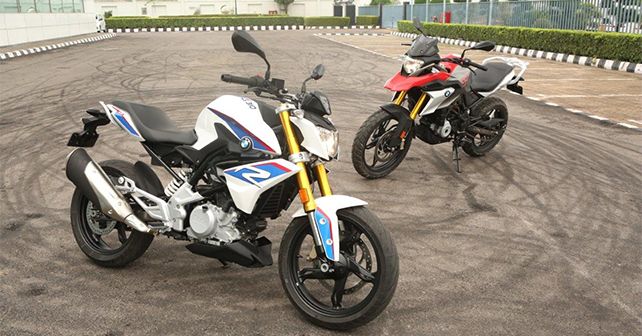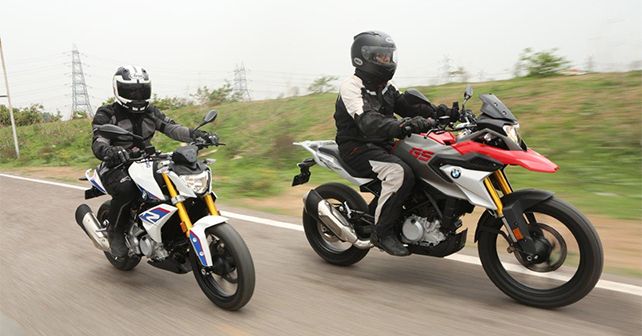
The high price tags of the BMW G 310 R and G 310 GS have deterred a lot of prospective customers. But, could it be that this is what BMW has been secretly wishing for?
While a lot has already been said about the pricing of the new BMW G 310 twins, there’s still some scope left for more debates, or so we believe. You see, nobody was expecting BMW Motorrad to price the G310 R and G 310 GS ‘reasonably’, but then we were also not expecting them to venture that far with their price-tags. In case you need reminding, the G310 R is priced at ₹2.99 lakh, whereas the adventure derivative, the G 310 GS, will set you back by ₹3.49 lakh – both are ex-showroom prices.
Of course, the pricing has split the audiences into two camps – those who think it’s alright for BMW to charge a hefty premium because these bikes are, um, BMWs, and then there’s the rest, who hold the belief that BMW has gone overboard with the prices of the G 310 twins in India.
The sensible thing then is to start the argument with what most are saying or rather cribbing about – the fact that the BMW G310 twins are exorbitantly expensive. The reason behind this hue and cry is simple – at ₹2.99 lakh, the G 310 R costs around ₹75,000 more than the TVS Apache RR 310 – a motorcycle that not only shares the same underpinnings but also offers more features, better performance and a sleeker bodywork. Then, to make matters worse, there’s the KTM 390 Duke, which is around ₹50,000 cheaper and has got even more power and more equipment (ride-by-wire, LED headlamp, colour instrument cluster and more) than the G 310 R.
Now, if that’s not enough, a look at the on-road price of G 310 R would do the trick – in Delhi, it retails for around ₹3.70 lakh on-the-road, which includes 3-year RSA (road-side assistance) and a logistic charge of ₹15,000. If you want to get yours in Style HP shade (pearl white), then don’t forget to add ₹10,000 on top of all of that. At that price, it gets absurdly close to the Yamaha R3 – a twin-cylinder and do-it-all motorcycle, that’s also our current favourite in the sub-500cc segment. Speaking of twin-cylinder bikes from the segment, we must also tell you that Kawasaki has also dropped the bomb (on BMW) by slashing the price of the Ninja 300. It now retails at ₹2.98 lakh (ex-showroom), which is a darn good deal by any measure.
It’s no different with the G 310 GS, and like its sibling, it’s also priced quite high – ₹4.26 lakh (on-road, Delhi). Plus, the extra ₹10,000 for the white colour. Agreed, it’s the only light-weight adventure/dual-purpose motorcycle in that price range and carries the legendary ‘GS’ genes, but again, it’s not a fully kitted-out off-roader from the get-go. You’ll have to make some necessary modifications – spoke wheels and chunky off-road tyres, to start with – before even thinking to take it to those hardcore trails up in the Himalayas.
In the BMW G310 models’ defence, we’ve to say that they do feel better finished than the TVS, or for that matter, any of the competition. And, if we’re honest, the 313cc motor that also does duty on the Apache RR 310 feels more refined on the G310 R and G 310 GS. But, do these two points warrant such a high premium? Well, even hardcore BMW loyalists will find this hard to justify.
You might imagine then that BMW will find it hard to move many units of the G 310 twins to the road. And that’s probably going to be the case because, maybe, that’s what BMW is aiming for. And the reason for that is quite simple. You see, a lot of buyers aren’t necessarily looking to hoon around on streets, wearing orange colours and squeezing every horse out of the motor. Similarly, a fully-faired motorcycle isn’t just everyone’s cup of tea. And this is exactly the case with the G 310R. You spend a considerable amount of money on a single-cylinder motorcycle, but in return, you get a motorcycle that’s relatively sedate and of high-quality. There’s a BMW badge too, which means you get a premium buying and after-sales experience. Of course, it might sound unwise to ‘reasonable’ minds, but there are people – even if they’re a minority – who think and act differently. And perhaps that’s who BMW wants to cater to and not the masses.
The story for the G 310 GS is similar for the most part, but it has some strengths. First of all, it has the first mover advantage in the segment, meaning it will attract buyers on its merits. Yes, it’s pricing will prevent customers from taking the final leap, and the fact that the KTM 390 Adventure is around the corner won't help its case either. But, for someone who can’t wait any longer and is looking for a simple, lightweight and reliable adventure bike – and this applies to customers coming from bigger motorcycles too – the G 310 GS will come across as a sweet little tool with fewer complications.
Long story short, it seems that BMW India isn’t much interested in the numbers game here – just like what they’ve been telling us is the case with its four-wheeler division for years now. Their aim is to rope in buyers who don't mind spending extra cash to own a BMW product. Also, with just nine Motorrad dealerships in the country, BMW surely isn't aiming to break the sales records in the sub-500cc segment. So, while most of us think the G 310 models' pricing in India is nothing short of a debacle, maybe we're missing the bigger picture.
























Write your Comment